Stylish Pedestal Sink Ideas for Small Bathrooms
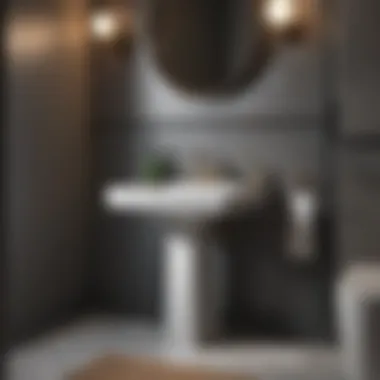
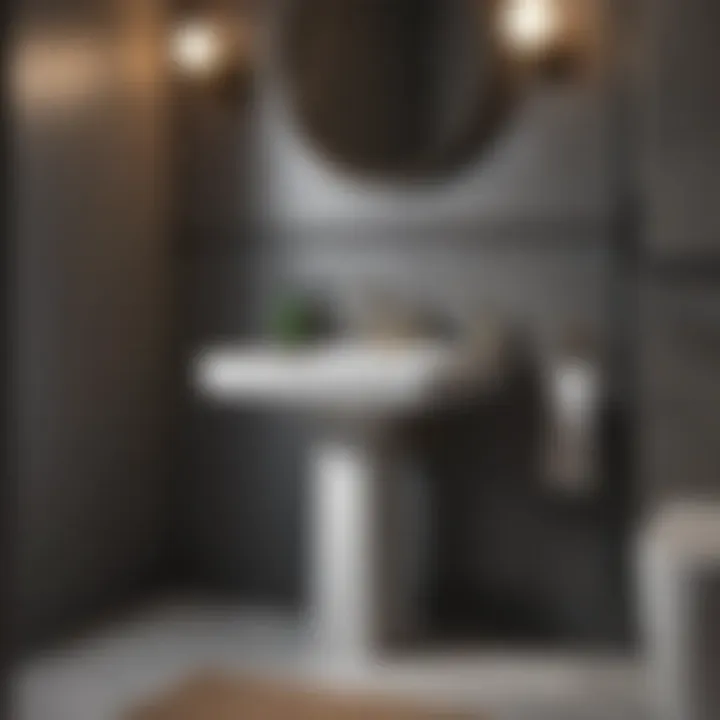
Intro
Small bathrooms often present unique challenges, but they also offer boundless opportunities for creativity. One major design choice that stands out is the pedestal sink. Not only does it save space, but it also provides an aesthetic charm that can elevate the entire room’s look. In an era where functional design meets sleek simplicity, pedestal sinks emerge as a fantastic focal point.
The goal here is to transform those compact spaces into an oasis of style while maintaining practicality. By utilizing current design inspirations and smart functional elements, you can maximize every inch of your small bathroom. This article will guide you through those intricacies—from fresh trends to space-saving solutions, ensuring that you craft a bathroom that reflects your taste and meets your needs.
Design Inspirations
Latest Trends in Bath and Bedroom Design
When it comes to contemporary bathroom design, minimalism continues to reign supreme. Seamless lines, neutral color schemes, and clever use of materials dictate the current landscape in bathroom decor. Pedestal sinks fit perfectly into these trends; they have a sleek, unobtrusive design that doesn't clutter the visual space. A bathroom with a pedestal sink often feels more open, even on the smallest scale.
Think about incorporating materials like ceramic, porcelain, or even stone to enhance that modern vibe. For example, a white ceramic pedestal sink can beautifully juxtapose with darker wall colors, creating a striking contrast that engages the eye without overwhelming a small space.
Another trend that's gaining traction is the emphasis on sustainability. Eco-friendly fixtures, natural elements, and finishes that look crafted rather than mass-produced are increasingly sought after. Bamboo shelves complement a pedestal sink wonderfully, adding both functionality and a touch of nature to the space.
Color Palettes and Themes
When selecting a color palette, consider soft, muted tones that enhance the sense of space. Shades like blush pink, soft lavender, or powder blue can make a room feel airy, while providing warmth. On the flip side, darker hues, such as deep navy or forest green, can create an intimate atmosphere—perfect for relaxation.
In terms of themes, vintage or retro styles can harmonize well with pedestal sinks, often drawing on their historical design allure. Pair a white porcelain pedestal sink with old-fashioned fixtures, and you create a timeworn elegance that’s utterly inviting.
Furthermore, coastal or nautical themes can breathe life into small bathrooms. Imagine soft whites paired with sea-foam colors, accented by light wooden elements. It brings an essence of tranquility and freshness to an otherwise confined space.
Functional Elements
Space Optimization Tips
Once you’ve narrowed down your design inspiration, it's crucial to utilize space efficiently. Wall-mounted shelves or corner units can store items without taking up valuable floor space. This can keep things organized without cluttering the countertop, allowing the pedestal sink to shine as a central piece.
When placing the pedestal sink, ensure it is not just functional but also harmonious with the overall layout of the bathroom. Keep frequently used items close by, but neatly stored. Small baskets or decorative boxes can enhance the aesthetics while holding essentials like extra toiletries or hand towels, striking that balance between beauty and practicality.
Multi-Functional Furniture Choices
Choosing versatile furniture is also a smart move. Mirrors with built-in shelves, or cabinets that double as seating, can maximize functionality while maintaining a stylish aesthetic.
Imagine a compact ottoman that hides bathroom linens or a tall, slim cabinet that can store cleaning supplies. Even a folding stool can provide extra seating without overwhelming the space.
Remember, it’s about creating a bathroom that works for you—a reflection of your style while remaining highly functional. The synergy of a beautiful pedestal sink with smart storage solutions is what ultimately leads to a small bathroom that feels open and organized.
"Design is not just what it looks like; design is how it works." - Steve Jobs
In summary, the thoughtful integration of pedestal sinks into small bathroom designs can create not just a visually appealing space but a practical one as well. By embracing emerging trends, color palettes that evoke emotions, and clever space-saving furniture, homeowners can truly transform their small bathrooms into chic retreats.
Understanding Pedestal Sinks
Pedestal sinks are a classic choice for small bathrooms, merging utility and style in a single unit. Their slender profile frees up floor space, making them a go-to solution for those looking to make the most out of compact areas. In this section, we will explore the defining traits of pedestal sinks, the practical advantages they offer, and what makes them a centerpiece in small bathroom design.
Definition and Characteristics
A pedestal sink is characterized by its basin that rests atop a column-like structure. This design not only gives an attractive appearance but also simplifies plumbing. Unlike traditional vanities that can take up significant room, pedestal sinks are often perched on a slender base that takes up little floor space, thereby offering a spacious feeling.
Pedestal sinks come in a variety of shapes and sizes, from rounded bowls to more rectangular designs, catering to diverse aesthetics. Many models feature materials such as porcelain and ceramic, known for their durability and ease of cleaning.
Benefits of Pedestal Sinks
Pedestal sinks convey a blend of form and function. They are more than just a pretty face; they have numerous benefits that make them a practical choice for homeowners.
Space efficiency
One of the standout features of pedestal sinks is their space efficiency. With their minimal footprint, they allow for movement in tighter areas. Imagine a sink taking up little space, giving the illusion of a bigger room, yet still providing a functional washing station.
- Key characteristic: The slim design means that you can fit essential features even in a snug corner of your bathroom.
- Beneficial for the article: Due to their reduced footprint, pedestal sinks are perfect for urban apartments and smaller homes, where every inch counts.
- Unique feature: Unlike bulky vanity units, which can crowd a small bathroom, pedestal sinks often leave the floor area open, enhancing the visual spaciousness of the room.
However, it’s worth noting that these sinks typically have limited storage options beneath them, which may be a disadvantage for some users.
Aesthetic appeal
The aesthetic appeal of pedestal sinks lies in their timeless elegance. They convey a certain sophistication that can elevate the overall decor of a bathroom.
- Key characteristic: Many pedestal sinks offer clean lines and smooth surfaces that fit seamlessly with various design themes, from traditional to more modern looks.
- Beneficial for the article: Their stylish presence can create a focal point in smaller bathrooms, drawing attention and admiration.
- Unique feature: Whether you are going for a sleek, contemporary vibe or embracing a vintage look, there is a pedestal sink that can match your vision.
However, matching the sink's design with bathroom decor requires careful thought to avoid clashes with other elements.
Variety of styles and finishes
A myriad of styles and finishes available for pedestal sinks is another reason they have gained traction. Homeowners can choose from simple designs to intricate visual elements that showcase personal taste.
- Key characteristic: Finish options range from glossy white porcelain to rustic matte textures.
- Beneficial for the article: The variety ensures there is something that suits every aesthetic preference, enhancing the bathroom's overall look.
- Unique feature: Customization options allow homeowners to adapt the sink to their specific needs, adding a personal touch that can tie the bathroom together beautifully.
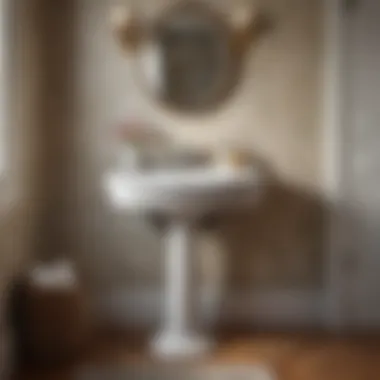
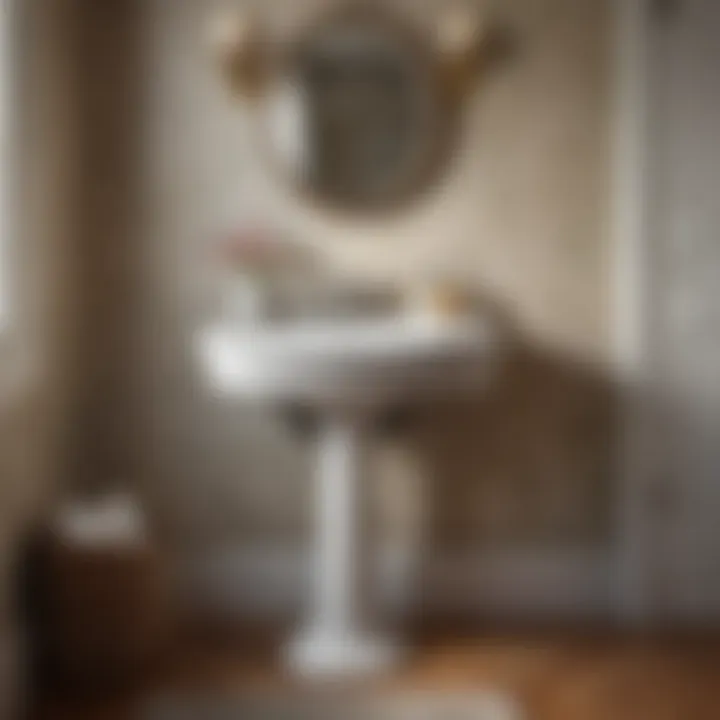
Nevertheless, with so many choices, deciding on the right style can sometimes feel overwhelming, leading to decision paralysis.
In summary, understanding pedestal sinks is crucial for anyone looking to enhance a small bathroom. They provide a unique blend of functionality and style, adaptable to various tastes and space constraints. The following sections will discuss how to thoughtfully integrate these sinks and maximize your small bathroom’s design potential.
Small Bathroom Design Considerations
Designing a small bathroom is like piecing together a puzzle; each decision impacts the final picture. Space constraints, sizes, and functionality play pivotal roles. It’s not just about slapping on a fresh coat of paint and calling it a day. One needs to think deeply about how these elements interact with each other and the overall flow of the space. A well-considered design can transform even the tiniest of bathrooms into a sanctuary.
Analyzing Space Constraints
When diving into any bathroom project, understanding the available space is crucial. Often, small bathrooms present an array of challenges. This means not only calculating square footage but also considering the shape and arrangement of the space. For example, a narrow room might only fit a petite pedestal sink any size excess can be somewhat a hindrance. A common mistake is trying to cram too much in, which ultimately does more harm than good.
It's essential to measure thoroughly and identify exact usable areas within the bathroom. Highlighting the limitations of your space can lead to more creative design solutions, presenting opportunities for innovative storage or decor arrangements. In this way, you churn constraints into advantages, not obstacles.
Choosing the Right Size
Standard dimensions
Standard dimensions for pedestal sinks generally range from 20 to 30 inches wide and around 30 to 34 inches tall. This type of sizing offers a perfect blend of convenience and accessibility, fitting snugly in tight corners without overwhelming the area. The uniformity in these measurements makes them a popular choice among homeowners looking for a fuss-free installation.
The benefit of these dimensions lies in their adaptability; they can harmonize with various bathroom styles while still remaining functionally effective. However, these sink sizes don't come without drawbacks. They primarily offer limited surface space for toiletries, which means extra storage solutions might be necessary elsewhere in the room.
Custom options
On the other hand, custom options present a thrilling twist to bathroom designs. These sinks let you specify dimensions to fit your unique layout. For instance, if you have an oddly shaped corner or a quirky angle in the room, you can tailor a pedestal sink that molds perfectly to that space.
The appeal of custom sizing lies in its flexibility. Homeowners can design a sink that aligns with their vision and requirements. But this customization often comes at a premium price tag, and finding a skilled craftsman to execute the design can prove challenging. Therefore, while custom options offer uniqueness, it requires some careful thought regarding budget and practicality.
Functionality and Flow
Traffic patterns
Flow is another crucial aspect when designing a small bathroom. This relates specifically to traffic patterns—the traditional route taken by anyone using the space. An ideal setup allows for smooth movement without obstacles. Placing the pedestal sink in a strategically advantageous location can optimize this flow.
For instance, clustering the sink, toilet, and shower together can minimize the distance one might need to walk while navigating the space. The inclusion of these patterns makes the bathroom more user-friendly, especially in a household where multiple individuals use it simultaneously.
Accessibility
Lastly, accessibility shouldn’t just be an afterthought; it is vital for creating a truly functional small bathroom. This includes ensuring that anyone, regardless of physical ability, can use all elements comfortably. Choosing the right height for the pedestal sink can make a significant difference here.
Features like grab bars or strategically placed towel racks might also enhance the usability of the space. While these additions may not seem important at first glance, they can drastically improve the overall experience of using the bathroom. So, while you may prioritize style, don’t overlook the benefits of fostering an easily navigable area.
Key Takeaway: Thoughtful design considerations are the backbone of an efficient small bathroom. By carefully analyzing space constraints, selecting appropriate sizes, and ensuring easy functionality, even the tiniest bathroom can be both stylish and practical.
Design Themes for Small Bathrooms
When it comes to crafting small bathrooms, the right design theme can make all the difference. It shapes the look and feel of the space, influencing not only aesthetics but also how one interacts with the environment. Choosing a coherent design theme can visually expand your limited square footage, making your bathroom appear larger and more inviting while still maintaining function. Plus, it allows elements like pedestal sinks to align seamlessly, enhancing overall harmony in the room.
Minimalist Aesthetic
The minimalist aesthetic embraces simplicity, where less truly becomes more. It focuses on clean lines, neutral colors, and a lack of clutter. In a small bathroom, this approach is particularly effective. A pedestal sink fits perfectly into this concept, providing essential functionality without overwhelming visual space. With fewer elements, every piece becomes more significant, allowing for thoughtful selections in color palettes and materials.
For instance, a white pedestal sink paired with light bamboo or oak accents can foster a soothing atmosphere. Opting for a single-piece mirror that stretches across the wall could enhance the sense of space while creating a sleek look. This style complements bright light fixtures that emit clear, white light, creating an airy, spacious look.
Vintage Charm
Vintage charm taps into nostalgia, invoking warmth through classic design elements. Incorporating a vintage pedestal sink can act as the centerpiece of the room, reflecting both history and elegance. Picture a sink with intricate floral patterns, perhaps in a soft cream or pale pastel hue to enhance that nostalgic appeal.
Other ways to evoke a vintage charm include brass or copper fixtures, antique-style mirrors with ornate frames, and patterned wallpaper or tiles. Coordinating colors such as muted greens, soft yellows, and gentle blues can charm the space, drawing in those who desire a warm, inviting bathroom. Accessories like vintage-style lighting — think filament bulbs in metal fixtures — can finish off the look beautifully, tying everything together.
Contemporary Style
Contemporary style is all about embracing current trends while keeping functionality at the forefront. This design theme suits small bathrooms particularly well, as it often involves maximizing available space and incorporating smart designs. A pedestal sink with geometric shapes and a sleek finish can capture the essence of contemporary style effortlessly.
Consider incorporating floating vanities, sleek glass or chrome accents, and minimalist art pieces that evoke modern sophistication. The color palette can range from bold black and white contrasts to soft, muted tones, creativity dictating the final choice. A contemporary bathroom thrives on lighting; consider LED strip lighting beneath cabinetry or bright recessed lamps to create atmosphere. Such features not only enhance visibility but also add an architectural feel to the design, showcasing the beauty of the space.
Rustic Influences
Rustic influences bring a down-to-earth charm, merging organic materials with a cozy ambiance. Picture a small bathroom featuring a pedestal sink constructed of reclaimed wood or a sink with earth-toned ceramic details. The key here is to use materials that ground the space, connecting it to nature and providing a sense of comfort.
A rustic-style bathroom can include rough-hewn cabinets, woven baskets for storage, and natural wood beams across the ceiling. Shades of terracotta, forest green, and sandy beige can paint a rich palette that evokes the countryside. Incorporating plants or even small herb gardens can breathe life into the space while promoting sustainability. With the right accessories, from vintage-style baskets to handmade soaps, a rustic bathroom can serve as a personal retreat, providing both style and serenity.
Color Schemes and Finishes
The choice of color schemes and finishes plays a crucial role in defining the aesthetic and functionality of small bathrooms, especially when incorporating pedestal sinks. When space is limited, the right color palette can make a space feel larger, more inviting, or even calming. Finishes also contribute to the overall style, influencing everything from the perceived cleanliness to the warmth of the room. Color and texture can be combined to create visual interest and depth, which is essential in small areas where every detail counts.
Light and Bright Colors
Using light and bright colors in a small bathroom can significantly enhance the sense of space. Shades like soft whites, pale blues, and gentle pastels reflect natural light, making the room appear airy and open. This is particularly advantageous with pedestal sinks, which already promote a sense of spaciousness due to their streamlined design.
- Ideal Combinations: Combine light walls with a white or light-colored pedestal sink.
- Factors to Consider: Take into account your bathroom's natural lighting. Colors may appear different depending on available light.
- Emphasis on Cleanliness: Light colors often invoke feelings of cleanliness and freshness, crucial in bathrooms.
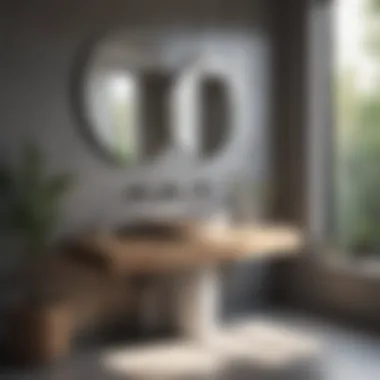

Bold Accents
Integrating bold accent colors can serve as a visual pop that injects personality into an otherwise serene environment. For instance, a striking navy blue or a deep forest green for the small accessories around a pedestal sink can make a significant impact without overwhelming the space.
- Key Benefits: They create focal points that draw the eye, elevating the overall design without requiring major renovations.
- Intended Snags: Be cautious—too many bold accents can clutter the small space, diluting their effect.
Textured Finishes
Incorporating textured finishes can add depth and interest to the small bathroom. Different surfaces like matte or glossy can drastically influence the perception of the space's style and cleanliness.
Matte vs. glossy surfaces
Matte finishes have become increasingly popular due to their understated elegance. They absorb light rather than reflect it, which can make a small bathroom feel more sophisticated and cozy. On the downside, they may show smudges more readily, demanding consistent maintenance. Glossy surfaces, on the other hand, can make a small space feel sleeker and often reflect more light, which helps in giving an illusion of spaciousness. However, they can also emphasize imperfections in the surface, requiring careful selection during installation.
- Consideration: When choosing between matte and glossy, think about the room's overall theme and the amount of cleaning you're willing to undertake.
Natural textures
Natural textures bring elements of the outdoors into the small bathroom, creating a calming, organic feel. Materials like stone, wood, or even bamboo can tie well with a simple pedestal sink, providing a contrasting textural element that softens the overall feel.
- Popularity: This trend has gained traction due to a growing focus on eco-friendly design and living.
- Balancing Act: The challenge lies in pairing such textures without overwhelming an already compact space, requiring careful selection of where to utilized natural elements.
"The key to utilizing color and finishes effectively is to strike the right balance between functionality and design, especially in tight quarters where every choice counts."
Maximizing Storage Solutions
In the realm of small bathroom design, efficient storage solutions can make or break the functionality of a space. With limited square footage, every nook and cranny needs to be optimized to keep the area organized and clutter-free. The goal is to strike a balance between accessibility and aesthetics, ensuring that essentials are easy to find while still maintaining a stylish appearance. By focusing on strategic storage options that blend seamlessly with pedestal sinks, homeowners can achieve a clean, open look that maximizes utility without compromising the charm of the decor.
Under-sink Storage
Organizers
Organizers are versatile tools for managing the space beneath a pedestal sink. They typically come in various sizes and designs, ranging from tiered shelves to pull-out baskets. A key characteristic of organizers is their ability to utilize vertical space effectively, providing multiple levels for storing toiletries and cleaning supplies. This choice is beneficial for small bathrooms because it ensures that items are not just shoved in a chaotic manner but neatly arranged for easy access.
One unique feature of many organizers is their modular designs, which allow homeowners to customize them according to their unique needs. However, it’s essential to choose an organizer that correctly fits the available space below the sink, as an ill-fitting option can defeat its purpose and lead to additional clutter.
Baskets
Baskets serve as another practical solution for under-sink storage in a small bathroom. They come in various shapes, sizes, and materials, making it easy to find options that match the bathroom’s overall aesthetic. A key characteristic of baskets is their flexibility; they can be moved around as needed and used for different purposes, such as holding extra towels, cleaning supplies, or personal items.
The unique feature of baskets lies in their design—which often includes natural textures that add warmth to the bathroom. However, one disadvantage is that, unlike organizers, they might not fit into all available spaces neatly, requiring more creative placement and arrangement.
Wall-mounted Shelves
Design considerations
When it comes to maximizing storage in a small bathroom, wall-mounted shelves are an excellent option. They utilize vertical space, freeing up room on the floor while storing frequently used items. A key characteristic is their customizable nature; shelves can be installed at various heights depending on the user’s needs. This versatility makes them a popular choice for small bathrooms as they adapt to different styles and preferences.
One unique feature to consider when adding wall-mounted shelves is their ability to integrate into existing decor. For instance, a rustic wooden shelf can bring a natural charm to a contemporary setting or frame the space around a sleek pedestal sink nicely. However, a drawback might be that improper installation can lead to safety concerns, especially if shelves become overloaded or misplaced.
Material choices
The materials chosen for wall-mounted shelves can significantly impact both function and style in a small bathroom. Choices often include wood, metal, or glass—each bringing its own unique feel to the space. A key characteristic of material choices is their durability and ease of maintenance, as humid environments can affect certain finishes.
For example, metal shelves can provide a modern touch and are typically resistant to moisture, making them a practical choice. However, glass shelves, while visually appealing, can be more susceptible to chips or shattering if not handled carefully. Ultimately, selecting the right material will ensure that the shelves not only serve their purpose but also align with the overall design aesthetic of the bathroom.
Utilizing Vertical Space
Tall cabinets
Tall cabinets present a smart way to maximize storage in a small bathroom without consuming too much floor space. They take advantage of the height of the room, often featuring multiple shelves or compartments for organizing essentials. A key characteristic of tall cabinets is their ability to be both functional and stylish, blending seamlessly with pedestal sinks and other fixtures.
Homeowners appreciate tall cabinets because they can store a variety of items from extra towels to cleaning supplies, all while keeping them hidden from view. Nevertheless, a consideration when adding tall cabinets is ensuring they do not overwhelm the room; they should complement rather than detract from the space.
Hanging storage solutions
Hanging storage solutions are another innovative approach to utilizing vertical space in small bathrooms. These can include hooks, racks, or baskets attached to the wall or the back of the door. A key characteristic is their versatility; they can be arranged to create an entirely unique look tailored to the homeowner’s preferences.
The unique feature of hanging storage solutions is that they can easily incorporate elements like plants or decorative pieces, thereby enhancing the room’s aesthetics. That said, they may require more frequent organization, as items are visible and can quickly become cluttered if not managed properly.
In summary, focusing on maximizing storage solutions not only promotes better organization but also enhances the overall ambiance of a small bathroom, allowing for both style and functionality.
Integrating Accessories and Fixtures
Integrating accessories and fixtures is a pivotal step in optimizing small bathrooms, especially those featuring pedestal sinks. It’s not merely about function; it’s about enhancing the overall aesthetic and experience of the space. Thoughtfully chosen accessories can complement the elegance of the sink while improving usability, ensuring that every inch of space serves a purpose. When considering accessories, factors such as color, style, and scale become crucial. These elements can either make or break the visual harmony of your small bathroom.
Choosing Complementary Faucets
The faucet is often the first detail to catch the eye in any bathroom setup. Selecting a faucet that works well with your pedestal sink is critical. A faucet's style can either underscore the sink's classic design or introduce a modern twist, depending on what you desire.
Consider styles like high-arc faucets for a contemporary touch or vintage-styled knobs for a more traditional vibe. This is where the conversation about material and finish comes into play. For instance, a brushed nickel faucet can add a sleek, modern feel, while a polished chrome option tends to reflect light and brighten the space—a crucial consideration for smaller areas that might lack natural light.


Selecting Mirrors
Mirrors do more than just aid in grooming; they can evoke an illusion of spaciousness, especially in compact rooms. By reflecting light and surroundings, the right mirror can dramatically alter the perception of space. There are two major types to consider:
Framed vs. Frameless
In the debate of framed versus frameless mirrors, each has unique attributes that serve different stylistic preferences. Framed mirrors can provide a sense of structure and often come with elaborate designs that can tie together the room’s theme. They can enhance traditional and vintage designs beautifully. However, a frameless mirror offers a clean and modern look that may align perfectly with minimalist or contemporary bathroom aesthetics. It easily blends into many styles yet provides the same functional benefits.
When selecting between the two, think about the overall theme of your bathroom. For a classic feel, opt for a frame that complements your sink; for a modern touch, go frameless for a more airy look.
Size considerations
The size of the mirror is essential as well. A large mirror can serve as a focal point and make the bathroom feel larger. However, in a small bath, a mirror that’s too large might overpower the space. Conversely, a smaller mirror can look lost in a cavernous room. The trick is to find a balance that complements the pedestal sink and surrounding decor.
A medium-sized mirror above your sink creates a harmonious focal point without overwhelming the area. Think about proportions carefully and opt for a mirror that enhances the functionality while still emphasizing the design.
Lighting Options
Good lighting can amplify the beauty of your small bathroom, particularly around the pedestal sink area. There are two primary forms of lighting to consider:
Ambient lighting
Ambient lighting serves as the main light source in your bathroom, creating an inviting and comforting atmosphere. You might consider softer lighting settings to create warmth without making the space feel cramped. A flush mount ceiling light can provide even illumination while eliminating shadows that could detract from the visual appeal of a pedestal sink.
This type of lighting is vital for practical reasons as well, aiding in daytime and evening routines. Assess placement carefully to avoid dark corners, as that might limit the overall function.
Task lighting
On the other hand, task lighting focuses on specific areas where detailed work is performed. This is particularly important near the sink for grooming tasks. Wall-mounted sconces or adjustable reading lights provide excellent solutions without taking up counter space. Good task lighting is crucial for clarity—ensuring the mirror reflects your true colors.
Choosing fixtures that match or complement the sink’s style yet provide adequate illumination can significantly enhance your bathroom's functionality.
In summary, integrating accessories and fixtures into your small bathroom plays a crucial role in marrying functionality with aesthetic appeal. Selecting the right components will not only improve usability but also enrich the overall experience of your space, making each grooming session a bit more enjoyable.
"Design is not just what it looks like and feels like. Design is how it works."
— Steve Jobs
By focusing on these elements, your bathroom can transition from a mere necessity to a thoughtfully designed retreat.
Maintaining Your Pedestal Sink
Maintaining your pedestal sink is an essential part of preserving not just its beauty, but also its functionality in a busy household. With the increasing trend of small bathrooms, pedestal sinks have become a favored choice due to their elegant design and space-saving attributes. However, even the most stunning sink can lose its charm if it isn’t well cared for. Regular maintenance not only prolongs the life of the sink but also ensures that it remains a hygienic and pleasant element in your bathroom. With the right cleaning techniques and upkeep, you can keep your pedestal sink looking fresh and appealing.
Cleaning Techniques
Cleaning a pedestal sink might seem straight-forward, yet proper techniques can make a world of difference in sustaining its aesthetics
- Daily Quick Clean: Using a soft cloth or sponge with mild soap or a gentle cleaner helps to quickly wipe down the surface. Paying attention to the faucet and drain areas is crucial, as these can accumulate residue quickly.
- Natural Cleaners: Given the materials often used in pedestal sinks, opting for natural cleaning solutions like vinegar and baking soda can be beneficial. For instance, applying a mixture of baking soda and water can help tackle stains without scratching the sink's surface.
- Avoid Harsh Chemicals: Strong chemical cleaners can be detrimental to the finish of the sink. Using acids or abrasive materials can scratch, discolor, or damage the surface. Instead, lean towards gentle, eco-friendly alternatives to maintain the integrity of the sink.
- Regular Deep Cleaning: Every couple of weeks, consider a deeper clean using a mixture of equal parts vinegar and water. This not only sanitizes but also helps to remove soap scum and mineral deposits that build up over time.
Remember to dry the sink thoroughly after washing to prevent water spots or any potential damage. A dry sink often looks more polished and inviting.
Regular Maintenance Tips
Engaging in regular maintenance practices ensures that your pedestal sink not only looks good but functions optimally over the years. Here are some practical tips:
- Inspect Pipes Regularly: Looking underneath the sink to check for leaks or corrosion on the pipes is advisable. If anything looks out of place, a quick repair can prevent major issues later.
- Sealant Checks: For those who have a glazed or coated finish, inspect periodically for any chips or cracks. If you spot an issue, resealing might be necessary to protect against water damage.
- Faucet Functionality: Keep an eye on the faucet itself, checking for any drips. A dripping faucet not only wastes water but can also lead to stains in the sink over time if left unchecked.
- Avoid Heavy Objects: While pedestal sinks appear sturdy, avoid placing heavy items on the edge. This can lead to cracks or unstable bases, which can be costly to fix.
"Regular upkeep is the unsung hero in maintaining the elegance of your pedestal sink. Simple checks and cleaning can save you a lot of headaches down the line."
Incorporating these techniques into your routine can help significantly. By embracing a few cleaning practices and maintenance tips, you can ensure your pedestal sink remains a splendid feature of your small bathroom, blending functionality with style.
Case Studies and Inspiration
When tackling the challenge of designing a small bathroom, practical examples can serve as a valuable source of inspiration. Case studies highlight successful transformations that have utilized pedestal sinks, showcasing not just aesthetic appeal, but also the smart use of available space. These examples provide insights into innovative design choices that might work in various settings, big or small.
Successful Small Bathroom Transformations
In the realm of small bathroom design, case studies often reveal the magic that occurs when functionality meets creativity. Consider a residence where a bulky vanity once consumed most of the space. By replacing it with a sleek white pedestal sink, the entire ambiance changed. This simple swap created a sense of openness and airiness, allowing light to bounce around the room.
Many homeowners have successfully integrated pedestal sinks into their designs, yielding numerous interesting styles. For instance, a small bath experiencing a traditional makeover employed a vintage-style pedestal sink, complemented by charming subway tiles and classic fixtures. This combination not only maintained functionality but also communicated the homeowner's love for history.
Here are some key elements observed in successful transformations:
- Smart Sizing: Choosing a pedestal sink with a smaller footprint, leaving room for other elements
- Color Coordination: Using color effectively to make the space feel larger
- Functional Accessories: Implementing shelves above the sink to maximize vertical storage
Each case serves as a testament that with thoughtful design, even the tiniest bathroom can shine.
User-submitted Designs
Diving into user-submitted designs genuinely illustrates the popularity and versatility of pedestal sinks in small bathrooms. Many homeowners share their personal journeys through platforms such as Reddit and Facebook, offering a look at what can be accomplished in less-than-ideal spaces.
These contributions often highlight individual styles, be it modern, rustic, or eclectic. One submission featured a bold black pedestal sink in a light-colored bathroom, creating a striking contrast. Added plants on the windowsill and framed artwork complemented the vibrant design, underscoring how details can elevate fragility into charm.
When gathering inspiration from user submissions, pay attention to:
- Lighting Choices: Natural light can dramatically enhance the bathroom's look
- Material Selection: Unique materials like reclaimed wood or copper can support a stylish flair
- Personal Touches: These small elements reflect the individual’s taste, providing a guideline on how to express personal style within a limited area
Ultimately, the round-up of case studies and user-submitted designs reveal that there’s no one-size-fits-all approach to bathroom design using pedestal sinks. Every project tells a story, emphasizing the beauty in individual expression and the art of making small spaces function effectively.















